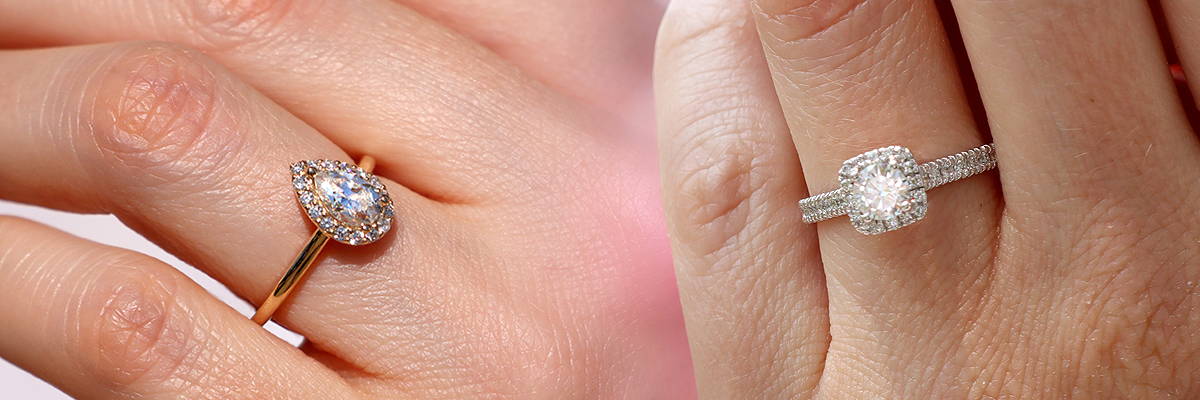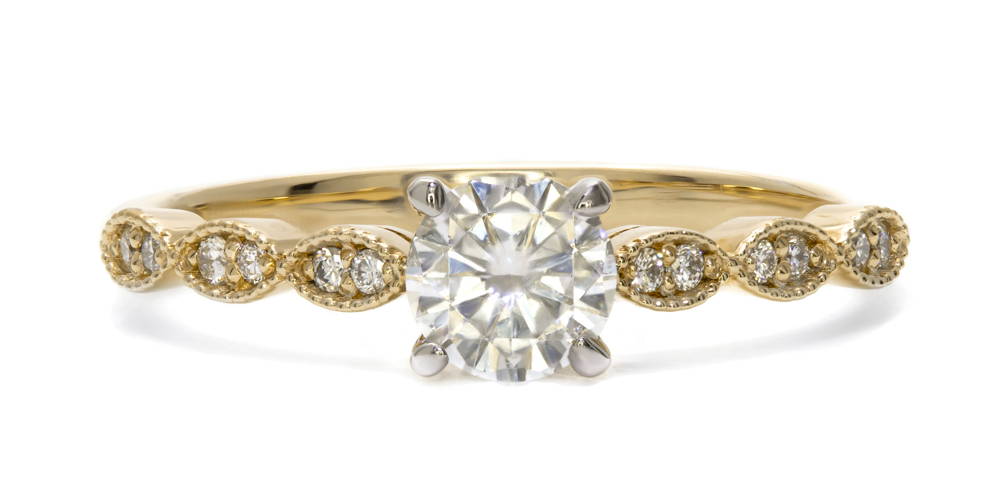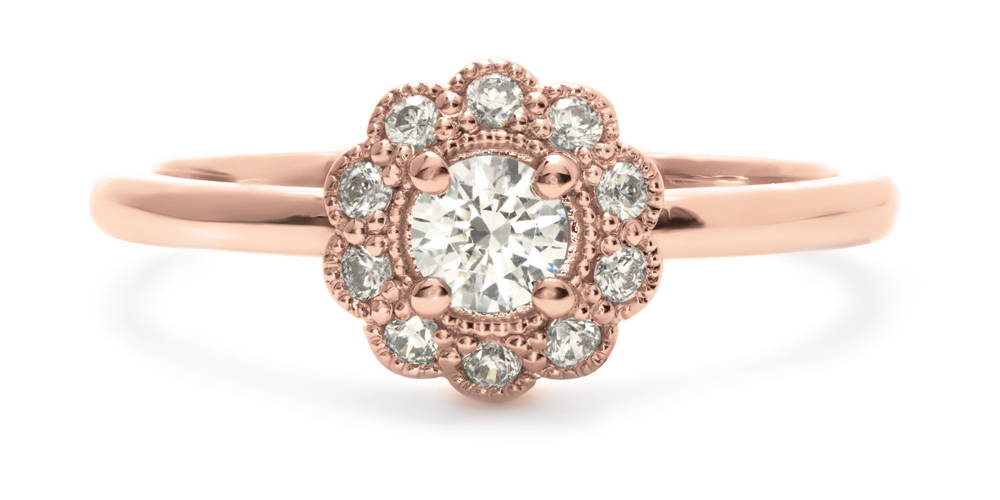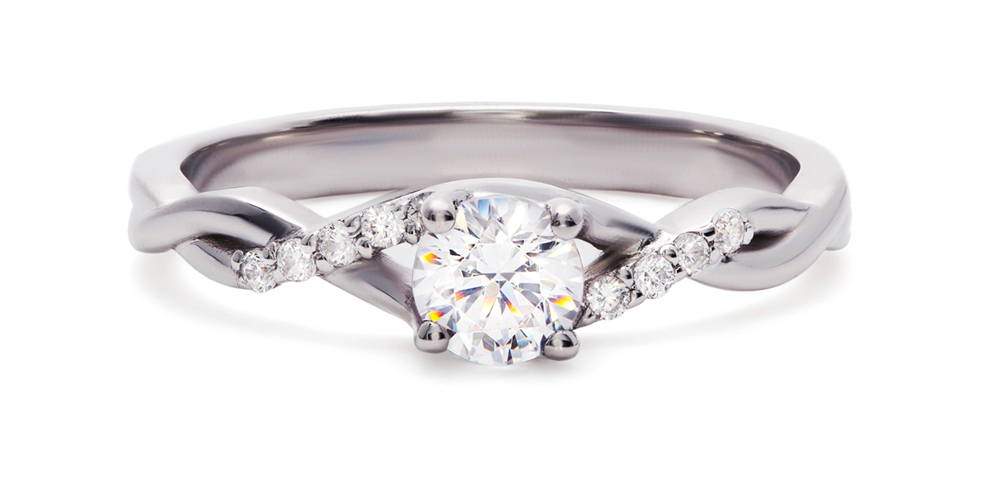
How to choose the right ring size?
Choosing the correct ring size is essential to ensure a perfect, comfortable fit. It's like a piece of clothing that must be cut to your measurements. The size of the ring is defined by measuring the circumference of a circle at the location where the ring will be worn. When it comes to finding the size of your own finger, you have several options. It gets a little more complicated if you have to measure the size of another person's finger, especially if the operation must be done secretly. No matter the situation, we will guide you and find solutions for you. How to choose your ring size will therefore become a simple formality.
How to choose your ring size
There are several simple methods to find out your ring size . We will come back to this in more detail in the article, but it is possible to measure your finger size using a ring sizer, a string, or simply by calculating the circumference or diameter of an example ring. A quick mathematical reminder before continuing, the circumference is the total measurement of the perimeter of a circle which is, in this case, the ring. The diameter is the straight line defining the distance between two points located opposite each other on a circle.
This is where the famous mathematical formula with the number Pi becomes very useful. This irrational number, equal to 3.141, allows you to calculate the diameter from the circumference and vice versa. To get the diameter of a circle, you divide the circumference by Pi . Conversely, you multiply it by the diameter to get the circumference.
In jewelry stores in France and other European countries, the ring size corresponds to the circumference of the finger. In some other places in Europe, the diameter of your finger determines the size of your ring. Here in North America, ring size is calculated on a scale of 1 to 15 with half points. (ring size 6, ring size 6.5, etc.) To obtain the size from the circumference or diameter, you absolutely need a conversion table for Canada and the United States. The conversion is not done from a logical calculation. You can consult the conversion table also called the size guide at the bottom of this article.
Usually, the size of a woman's ring is between 4 and 9. The ring for men, of larger size , varies between 7 and 12. There is no standard size and the circumference of your finger has no connection with your height or build.
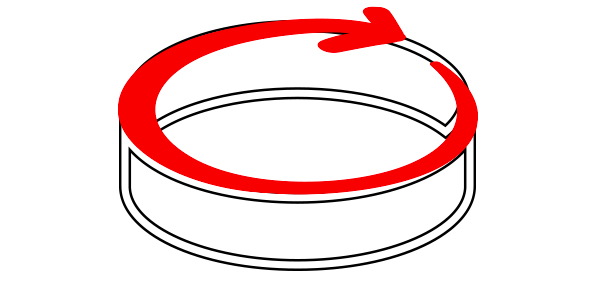
Circumference
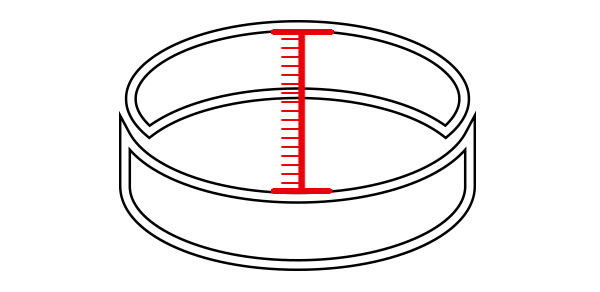
Diameter
Why Ring Size Matters
The importance of ring size should not be neglected for several good reasons:
- Comfort: A ring that is too tight can cause discomfort or even circulation problems, while a ring that is too loose risks falling off.
- Aesthetics: A well-fitted ring will highlight your finger and complement your overall appearance.
- Emotional: Rings are often given on special occasions like engagements, weddings and anniversaries. An ill-fitting ring can reduce the emotional impact of the gesture.
- Daily activities: The wrong ring size can be particularly distracting during daily activities, such as writing, typing, or any other task requiring use of the hands.
Risks associated with an ill-fitting ring
An ill-fitting ring carries its share of risks such as these:
- Skin health: An ill-fitting ring can cause skin irritation, especially if it's made of a material you're allergic to.
- Safety: If the ring is too loose, there is a risk of losing it or damaging it if it is dropped.
- Wear and Durability: A ring that is too tight or too loose will experience uneven wear, which can reduce its longevity.
- Conversion Cost: Although some rings can be resized, it can be expensive and sometimes risky to alter the structure of the ring, especially if it has stones inlaid all around it.
How to measure your ring size
There are several methods to measure the circumference of your finger and thus know the size of your ring. Here are some commonly used ones for how to measure your finger for a ring .
String method
- Cut a small piece of string.
- Wrap it around the base of the finger where you wear your ring.
- Mark where the wire crosses
- Measure this length using a ruler.
- This length is used to calculate the circumference.
- Check the size guide to get the finger measurement for the ring .
Exemplary ring method
- Take a ring that suits you or the person you want to give a ring to.
- Place this ring on a ruler and measure the inside diameter in millimeters.
- Make sure this measurement is taken where the ring is widest.
- Consult the size guide.
Ring sizer method
- Order a free ring sizer here .
- Wrap the finger with the plastic strip in the right place.
- Follow the instructions on the envelope.
- Watch this explanatory video to understand how to measure your finger for a ring.
Note: Avoid virtual ring sizers. They are not precise and their impressions can skew the data.
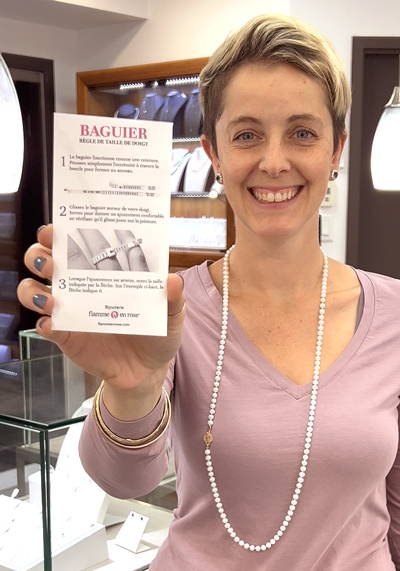
Free plastic ring sizer
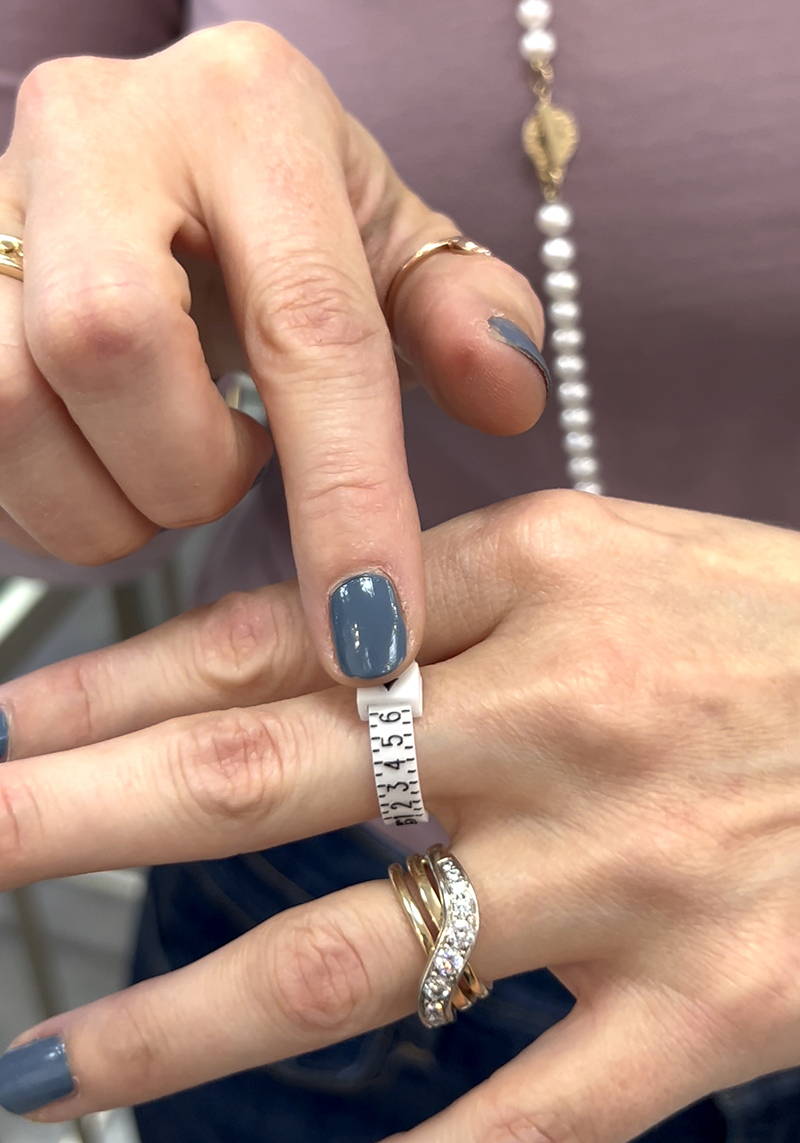
Measuring on the plastic ring sizer
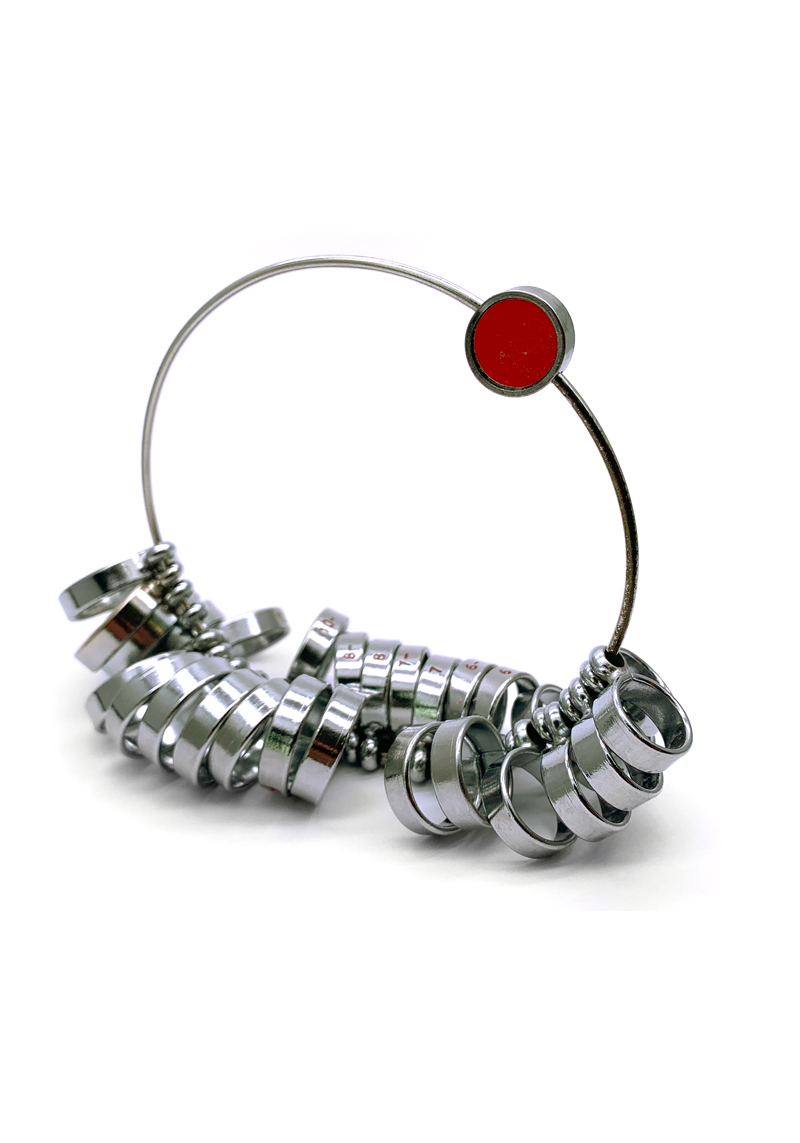
Professional ring sizer
Jeweler's method
- Find a trusted jewelry store.
- Get your finger measurement for a ring with the professional ring sizer.
- Jewelers have experience in measuring ring size accurately.
No matter which method you use, it's always good to check with a professional or test with another method to be sure.
Conversion and equivalence of ring sizes
Ring size conversion and equivalency are crucial considerations when looking to purchase a ring, whether for yourself or as a gift. In different countries, ring size measurement systems vary, making it sometimes difficult to choose the correct size.
Conversion from European size to Canadian size is often a concern for buyers and jewelers. A ring size chart can be particularly helpful in simplifying this process. This charter offers a complete overview of the equivalences between the different sizes, such as the conversion between the size 11 ring in the Canadian system and its European counterpart.
In the European system, sizes are generally expressed in millimeters, corresponding to the circumference of the finger. Thus, a size 52 in a European ring would be approximately equivalent to a size 6 ring in Canada. Likewise, a size 54 in a European ring would correspond to a slightly larger Canadian size, often a size 7 ring.
When talking about dimensions in centimeters, the conversion can also apply. For example, 6 cm in European ring size would be close to a size 60, which could be approximately a size 9 ring in Canada. As for 6.5 cm in ring size, this would correspond to a size 65 in the European system and could be equivalent to a size 11 ring in Canada.
Small sizes like ring sizes 4 or 5 in the Canadian system often correspond to European sizes like 47 and 49. A ring size chart, a correspondence table or size guide will be your best allies to navigate through these conversions and find the perfect size, whether in European or Canadian sizes.
Ring size conversion chart
The ring conversion chart is the ultimate tool that allows us to accurately read the ring size in Canada . We add to this the United States, which, in the vast majority of cases, uses the same size guide as its northern neighbors.
-
Correspondence table - Canadian and US sizes
Circumference
Diameter
Size
46.5 mm
14.8 mm
4
48 mm
15.2 mm
4.5
49 mm
15.8 mm
5
50.5 mm
16.1 mm
5.5
51.5 mm
16.4 mm
6
53 mm
16.9 mm
6.5
54.5 mm
17.4 mm
7
55.5 mm
17.7 mm
7.5
57 mm
18.1 mm
8
58 mm
18.5 mm
8.5
59.5 mm
18.9 mm
9
61 mm
19.4 mm
9.5
62 mm
19.7 mm
10
63.5 mm
20.2 mm
10.5
64.5 mm
20.5 mm
11
66 mm
21.0 mm
11.5
67.5 mm
21.5 mm
12
68.5 mm
21.8 mm
12.5
70 mm
22.3 mm
13
71 mm
22.6 mm
13.5
72 mm
22.9 mm
14
73.5 mm
23.4 mm
14.5
74.5 mm
23.7 mm
15
-
Conversion table - Canadian and US sizes
Circumference
Diameter
Size
46.5 mm
14.8 mm
4
48 mm
15.2 mm
4.5
49 mm
15.6 mm
5
50.5 mm
16.1 mm
5.5
51.5 mm
16.4 mm
6
53 mm
16.9 mm
6.5
54.5 mm
17.4 mm
7
55.5 mm
17.7 mm
7.5
57 mm
18.1 mm
8
58 mm
18.5 mm
8.5
59.5 mm
18.9 mm
9
61 mm
19.4 mm
9.5
62 mm
19.7 mm
10
63.5 mm
20.2 mm
10.5
64.5 mm
20.5 mm
11
66 mm
21.0 mm
11.5
67.5 mm
21.5 mm
12
68.5 mm
21.8 mm
12.5
70 mm
22.3 mm
13
71 mm
22.6 mm
13.5
72 mm
22.9 mm
14
73.5 mm
23.4 mm
14.5
74.5 mm
23.7 mm
15
It should be noted that several countries in the world use the ISO 8653 standard to define the sizes of jewelry rings , notably in France, Germany, Belgium, Austria, Scandinavia, the Netherlands and other continental European nations.
How to determine your ideal ring size
We can't repeat it enough, determining the ideal size of your ring is essential to guarantee comfort and style. So how do you know which ring size is best for you? Here are some tips to guide you through this process.
First of all, it is essential to measure the finger on which the ring will be worn. Finger sizes for rings vary not only from person to person, but also from finger to finger on the same hand. You can use several methods to find the ideal ring size as discussed earlier in the article.
Here are some things to consider when measuring finger sizes for rings .
- Finger Temperature: The size of your finger may change slightly depending on the temperature. Try measuring your finger when you are at normal body temperature.
- Time of day: It is best to measure your finger at the end of the day when fingers are typically at their largest.
- Knuckle Size: If your knuckle is significantly larger than the base of your finger, measure the knuckle as well and choose a size that will be comfortable for both.
Knowing how to determine the perfect ring size is a useful skill that every jewelry lover should master. For optimal accuracy, it is recommended to consult a professional jeweler to ensure a comfortable and aesthetically pleasing fit.
How to determine your ideal ring size
A comfortable ring fit minimizes the risk of skin irritation and circulation problems that can occur with a ring that is too tight. Additionally, a comfortable fit ensures the ring stays in place without slipping, which is especially important for gemstone rings like engagement rings .
A comfortable fit also enhances the aesthetic experience of wearing a ring since it will naturally blend with your hand without drawing attention for the wrong reasons. A comfortable ring fit is essential for the well-being, durability and elegance of your ring.
How to measure finger circumference
Both the string and ring sizer methods are effective for finding the finger measurement for a ring . Consider the size of your knuckle so that the ring can slide all the way onto your finger. Use the circumference formula explained in the paragraph on how to choose your ring size to obtain the equivalences in the conversion table.
How to measure your finger for a ring also applies to measuring another person's finger. Repeat the same methods explained in the paragraph on how to measure the size of your ring, taking into account the size of the knuckle and without tightening the finger too much. It is easier to shrink a ring than to enlarge it.
Using a ring sizer to determine size
Using a ring sizer is one of the safest methods for measuring the circumference of your finger. Once adjusted on your finger, all you have to do is read the number indicated to find out your Canadian size. Watch this video to understand better. We strongly suggest that you avoid the virtual ring sizer to print and order the plastic one. Some jewelry stores send the free ring sizer by mail.
Are you wondering how to know your ring size without a ring sizer? Here's a quick summary.Take a string, wrap your finger, mark the point where the string crosses, measure the length using a ruler, and use the conversion chart to translate the circumference of your finger to Canadian size. It's that simple.
FAQ – Frequently Asked Questions
1. How do I choose my engagement ring size?
Choosing the right size for your engagement ring is a delicate process. You can use both of these methods at home.
The string method:
Wrap a thin wire or rope around the finger you plan to wear the ring on. Mark the point where the wire crosses, then measure this length in millimeters using a ruler. Use a conversion chart to find the corresponding ring size.
The exemplary ring method:
Use a ring that fits you well and measure its inner diameter in millimeters. Consult a conversion chart to find the correct size. Repeat the exercise a few times to make sure your measurements are correct. For a very precise measurement, we recommend consulting a jeweler who has ring sizers and measuring tools that provide high precision. Avoid measuring your finger when it is very hot or very cold and preferably do it at the end of the day.
2. What is the standard ring size in Canada?
In Canada, there is no standard size as such since finger size varies from person to person. However, the most commonly purchased women's ring sizes are often between 6 and 7 in terms of North American measurement. In men, this range is typically between 9 and 12. However, while there are more commonly sold ring sizes, measuring accurately is essential to ensure a comfortable and secure fit.
3. How do I convert my ring size to US size?
If you start with a Canadian ring size, the conversion is simple since they are the same measurements. If you don't already know your ring size, measure it. You can use the wire method, the exemplary ring method or consult a jeweler for an accurate measurement. Once you know the circumference or diameter of your ring, use the conversion chart to find the US size equivalent.
Conclusion
Choosing the right ring size is a fundamental step in ensuring long-term comfort and satisfaction. Whether you opt for at-home measuring methods or consult professionals, it is crucial to take the time necessary to determine the ring size that is best for you.
Flamme en rose jewelry is an excellent choice to benefit from reliable expertise and excellent customer service. The on-site experts will not only help you accurately measure your finger but also understand the intricacies between different sizes and measurement systems. Their professional advice guarantees the best possible choice.

